A good example is the 'locked load' of sacks, loaded so they would not move or be blown off the wagon in transit. Several books on wagons have a photo of such a load of sacks but these were taken to show the stacking method and a tarpaulin would be added over the top of the load when moving. The pictures to look for are those of trains on the move or in marshalling yards.
Tarpaulins were draped over standard open wagons and roped to the hooks or rings provided on the sole bars or (as in the case of the BR OAA wagons) to small rings mounted on the body sides. Vans with a leak in the roof would often be covered with a tarpaulin, adding a little variety to a rake. Wagons with a peaked roof, such as salt or lime wagons, which had doors that were damaged or leaked were also often seen with a tarpaulin draped over them. Note that some lime wagons had no doors as such in the top but had a small tarpaulin cover instead. Cattle wagons were often pressed into service for seasonal fruit and veg traffic, for this duty they usually had a tarpaulin sheet added over the roof to cover the open upper sides.
Fig ___ Sheeted wagons
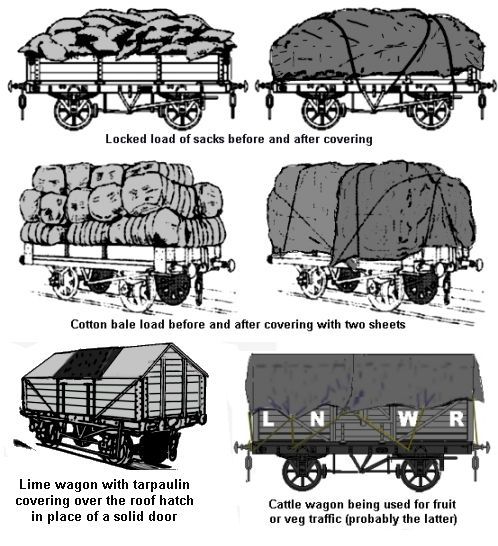
Tarpaulins and ropes from all participating companies were included in the common user scheme as of about 1917 (ropes were withdrawn in 1921) so it would be perfectly normal to have one companies sheet on another company wagon. They were valuable items however so would be returned to the owning company and were clearly marked with the owning company initials and a number.
Appearance in use
Tarpaulins were not a standard size, each company having its own requirements. Most were about twenty one feet long by about fourteen feet wide but the SECR, which had a fleet of wagons with high raised ends, used a number of sheets that were roughly square. Personally I make mine about 44mm by 26mm as paper is about a scale inch thick.
The sheets have eyelets in the edges and usually had triangular tags set in about eighteen inches with more eyelets. The eyelets were quite small and the ropes used to secure the sheet were correspondingly thin (no thicker than about half an inch or 12mm). They are roped down to rings on the wagon sides or solebars and the sheet often covered most of the side of the wagon, very handy if you made a mess of the lettering. As noted above some wagons had the rings fitted to the body sides and this meant that the bottom edges of the tarpaulin sometimes appeared folded up under the sheet.
Up to the 1960's the ropes or cords used to tie down the sheet were black. In the early 1960's the colour changed to mid grey but by the early 1970's orange polypropylene ropes were pretty much the norm.
Larger wagons or wagons with a high load usually had two tarpaulins laid across the wagon at each end and overlapping in the centre, protecting the load was more important than saving wear and tear on the sheets. Additional ropes were often added over the top to keep the sheet secure and avoid it flapping and becoming torn (BR seems not to have done this on wagons by the 1970's). Vans or containers with a leak in the roof would often be covered with a tarpaulin, which adds a little variety to a rake.
BR sheets for traditional (pre air brake) wagons were about 11 feet wide and about 21 feet long, draped over a low load they reached quite a long way down the sides of the wagon. When carrying a larger load BR seem to have used only a single sheet per wagon by the mid 1970's, so the edges of the sheet were often very close to the top of the wagon side when carrying a bulky load.
If your tarpaulins are sufficiently thin they can be moulded down over a dummy load to give the sheet a more authentic appearance. I have used short lengths of Q-Tip stems for oil drums, chopped up matches for cases and short lengths of square balsa wood or 'extra long matches' for bales. The 'sheet' was then soaked in water and pressed gently down over the load.
As noted in the sections of rolling stock design few wagons had raised ends or the added sophistication of a patent tarpaulin support bar by the later 1920's. Railway staff were instructed to try and avoid hollows when sheeting a wagon, generally the wagon load was built up in the centre, forming a 'tent' shape. Having said which there seem to have been quite a few sheeted wagon where the load was lower than the sides, resulting in a distinct 'dip' in the sheet. Adding a touch of clear varnish into such a dip gives the impression of trapped rainwater.
Fig ___ Sheeted loads
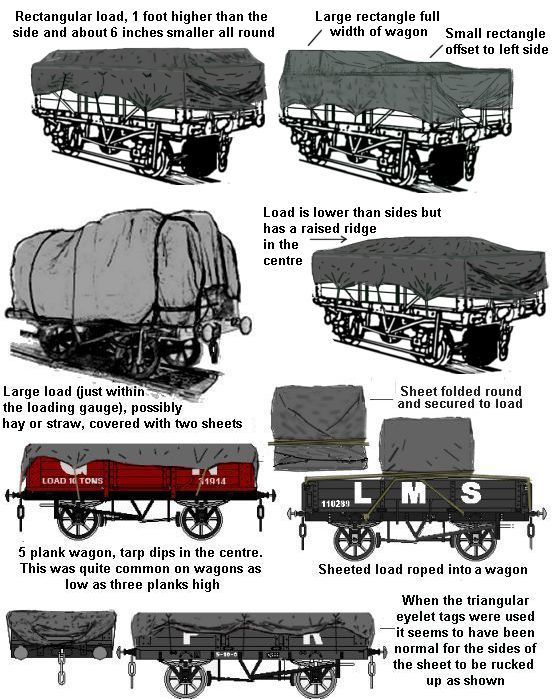
Large loads often required two sheets, however you can use a plain black sheet with a printed sheet over it to save money, the example shown below left was done in this way. The sheet was not always draped right over the wagon, quite often only the load itself was sheeted, which means you can make a removable load. To do this the load should be on a base of 10 thou card cut to be a snug fit inside the wagon (mine are fitted for width only as I have a lot of cut-about wagons of varying lengths). The photo below right shows a load (scrap of carved balsa) with a sheet (Smiths pre-printed type, discussed below) glued to it, sitting in a pre-grouping GWR three plank open wagon (cut down Peco kit).
Fig ___ Variations on sheet usage

Markings
Tarpaulins were made of white canvass (expensive) or light brown canvass (cheaper types) and waterproofed, I believe, with a mixture of soot ('best quality vegetable lamp black) and either gas works tar (cheap types) or linseed oil (more expensive, used by the railways). As with tarred roads they were only black when brand new, soon fading to an ever lightening grey in service. The markings on the sheets were painted on, often using a stencil, and faded to grey within a couple of years.
Tarpaulins were valuable so the owner would have them marked with their name or initials and the railway companies always added a number to each sheet. It was normal to have the date of manufacture marked on the sheet (usually in the form of a fraction with the number of the month above the last two digits of the year). As the owning company had to be identified when folded the lettering was often repeated on all four sides or some distinctive marking was added such as the white zig-zag line around the edge of Cheshire Lines sheets. Coloured bands were often used by the pre-grouping companies, adding these to home made tarpaulins is discussed below. Examples include the Caledonian Railway which had a blue cross running from the centre of each side and the London Tilbury and South End railway which had a red cross running diagonally from each corner.
Prior to the First World War many companies had quite elaborate designs, often featuring the coloured stripes, and the markings on tarpaulins occupied most of the sheet. The L&Y sheet features elaborate lettering and diagonal multi-coloured lines, they also produced an unusually long sheet for use with their twelve foot wheelbase wagons, both types are detailed in Lancashire & Yorkshire Wagons Volume 1. by Noel Coats. The lettering was only applied on one side although some companies added extra markings on the reverse for example the NER added a white cross in each corner and later the LMS had small (six inch high) markings on the reverse side.
Finding details of the markings used on tarpaulins has proved rather difficult, although over the last few years the Historical Model Railway Society and the enthusiasts who have worked so hard to produce the books on company wagons have redressed the balance somewhat. My own home made sheets are based on notes from my notebooks, wherever possible they have been taken from photographs. Do note however that the examples shown are not necessarily accurate, for one thing the companies occasionally amended the design used over time (see footnote below).
Fig___ Pre World War One Tarpaulin Markings
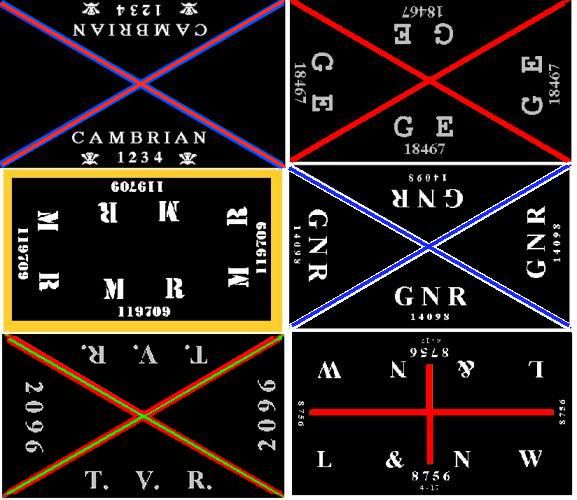
Following the First World War and the introduction of the common user arrangements it would be quite normal for sheets from one company to be used on a second company wagon, which might be seen on a third company line, keeping track of the sheets was another job for the RCH representatives at the various railway junctions, hence the prominently displayed sheet number. During this war there seems to have been a degree of simplification and standardisation with just the company initials about eighteen inches high above the sheet number about a foot high and sometimes below that the initials repeated in smaller text about eight inches high. This being repeated on all four sides in most cases. This was not universal, the pre grouping North Eastern Railway and the post-grouping Southern Railway appear to have had the initials on the longer sides only with the number against all four. Some companies stopped using coloured bands, replacing them with white, the LBSCR had a white X running corner to corner and the Cheshire Lines had a zig-zag white line running round the edges of the sheet.
Fig___ Post World War One Pre Grouping Tarpaulin Markings

A retired road haulier advised me that sheets in the 1930's lasted about four years in service, railway sheets were heavier so five or six years might be expected. The were however likely to be re-conditioned (re-waterproofed and re-stenciled) 'every few years'. It is unlikely therefore that the colourful pre war sheets were still in use by the time of the grouping.
In the 1930's the markings were further simplified with the just the company initials above the number, sized as before, applied to the shorter ends of the sheet as shown on the SR example below. This style was adopted by BR but by the mid 1960's they seem to have stopped using the initials (I could be wrong on that).
Fig___ Big Four Era Tarpaulin Markings
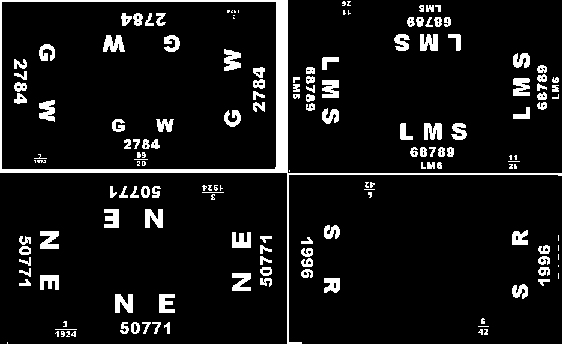
The markings on railway company tarpaulins often faded rather quickly in use, they sometimes do not show up in photographs, and a simple rectangle of cheap 'artists sketch pad' paper cartridge paper rubbed over with a piece of charcoal or washed with diluted Indian ink then well crumpled should suffice.
In use the black coating used to waterproof the cloth tarpaulins faded and in practice the standard tarpaulins supplied by British Railways for use with wagons of the older designs seem to have been a universal grubby grey (very faded black) with little trace of their original markings showing. The older cloth tarpaulins on the china clay wagons were generally stained white (as were the wagons) by the cargo. Cloth tarpaulins remained in use on BR throughout the 1960's but I believe they disappeared quite quickly in the later part of that decade.
The more modern plastic proofed tarpaulin was introduced in late 64 or early 65 with the change over taking about three or four years. Early examples appear to have been mid grey (similar to LMS wagon grey, slightly darker than BR wagon grey) and when new had B R and a number toward each end in white (possibly black on some specialised sheets). Later examples seem to have lost the BR but retained the number To get the 'plastic' look on a grey sheet a coating of diluted PVA works well. The grey plastic sheets lasted well into the 1980's.
In the later 1960's blue plastic sheets were supplied for fixed hoods such as those fitted to collapsible frames on the hooded steel coil wagons and the Shockhood B steel carrier. These sheets were not (easily) removable and did not carry BR branding although I believe some carried markings regarding their use. In the 1960's blue nylon wagon sheets were tried but proved too flimsy, I haven't traced any information on markings on these blue nylon sheets. Heavy blue plastic sheets appear to have been introduced in the mid 1980's, in the photographs I have seen they do not appear to have carried any markings. These heavy blue sheets were quite shiny and one options would be to use wax crayon to colour paper.
Some tarpaulins were marked for use with a particular type of vehicle and tarpaulins for specific wagons were often fixed to the wagon permanently. The tarpaulins for the open grain hopper wagons inherited from the SR and the longer tarpaulins supplied for the later air-braked wagons (which were larger than the old standard sheets) had special brandings applied to keep them with their wagon. In the latter case they had To be retained with AB open wagon' stenciled along the longer sides.
The plastic British Railways tarpaulins were often coloured on unusual wagons to avoid the possibility of their being switched to other stock, for example the (china) 'clay hood' wagons had blue sheets marked with the English China Clays logo blue and the anhydrite hopper tarpaulins were yellow, subsequent replacements might be grey however and colours varied in practice.
Fig___ BR Era Tarpaulin Markings
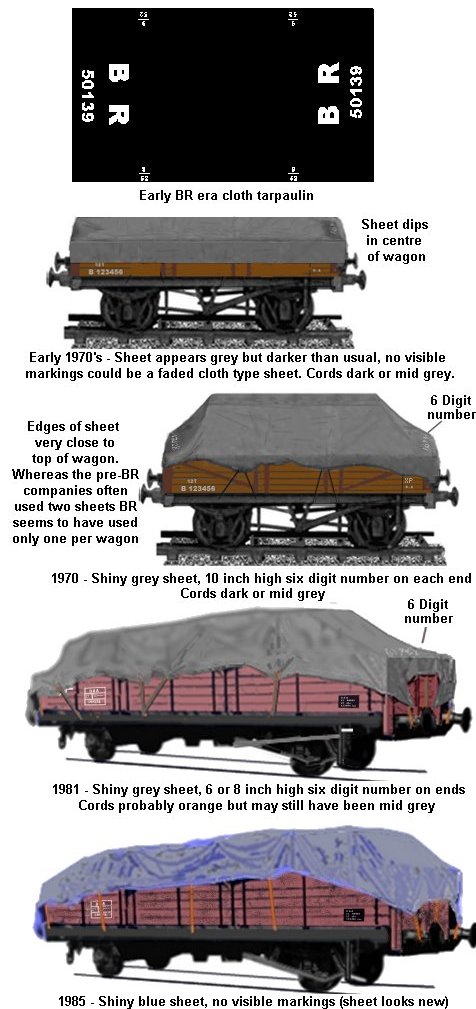
Commercial and DIY Tarpaulins
In 4mm there is a range of tarpaulins available from Roger Smith (reviewed in RM XXXXXX). In N Smiths introduced a very useful range of pre-printed paper tarpaulins in the 1970s, these disappeared for a time and were re-introduced by Howes of Oxford and are currently being marketed as a 'Smiths' product again. These are very easy to use, simply cut them out, crumple them up to give a more used appearance and glue them in place.
Fig___Smiths pre-printed tarpaulin sheets

The original Smiths sheets (as shown above) used a printing method which is now rare, as a result they 'faded' beautifully when crumpled. I recently purchased some of the current stock and these are printed by a different method that has a faint sheen and does not 'fade' when crumpled.
DIY tarpaulins can be made from cartridge paper dyed black (or dark charcoal grey) and Bacofoil, however these are difficult to letter. I have a number of wagons with hand-lettered sheets, I used Windsor & Newton white ink applied with a mapping pen and generally I am comfortable with the results.
Given a computer and an ink-jet printer it is not difficult to design the sheets yourself but the lettering is very small so you would need to use a printer with a resolution of at least three hundred dots per inch and printing black sheets is expensive in terms of ink. Laser printers and photocopiers are less suited as the 'ink' is a plastic that melts onto the surface of the paper and flakes off leaving plain white when crumpled (you can 'fill in' the unwanted white areas with a felt tip pen but this takes care). If you do not have a computer you can take a sheet of black paper, add the lettering from office lettering sheets or add them with a pen and white ink.
To get small lettering you can produce them over size and get your friendly local photocopying centre to reduce these to the correct scale size, however as noted above photocopies are not ideal. Do note if using photocopied or laser-printed tarpaulins the black dust which is used in the process will be lifted and smeared by many kinds of thinners, so use water based paints to add weathering. Most commercial photocopiers are not terribly accurate when enlarging or reducing, typically you will get a plus or minus five percent error. It is illegal to photocopy the Howes/Smiths sheets, besides it is not worth doing as they are cheap and 'crumple' better than photocopies.
The paper tarpaulins cannot easily be made removable, although I did make a couple which slotted onto my Peco wagons. To do this I carved some Balsa blocks to shape, making the lower part slightly larger than the Peco open wagon. I added some cling-film over the block and for good measure I smeared this with 'baby oil'. I then soaked the cut out Smith's/Howes sheets in diluted PVA glue, with a drop of detergent added to enable it to penetrate the paper and carefully formed this over the balsa block. Once dry the tarpaulin shapes were eased off the blocks and could be fitted onto a wagon body as required. I should note that in practice the oil proved difficult to remove from the sheet and stained the wagons. I found I seldom bothered adding or removing them from wagons on the layout and over the years they became damaged and have since been discarded.
As more than one sheet might be used on a wagon you can get away with having a few unlettered sheets with the lettered variety laid over the top. This also introduces variation in shade of grey which adds a bit of variety to canvass type sheets. Newspaper washed with diluted Winsor & Newton black ink works quite well for a faded sheet although it is best to use a bit of the paper with no printing on it. Crumple the sheet before fitting to give it a well-worn look.
Footnote
My notes on tarpaulin markings are mainly cribbed from articles in the model press over the years, there were a number of series of scale drawings published in the model press and some of these featured the details of tarpaulin markings. More recently the books on specific company wagons usually contain a drawing of the tarpaulins and often details of the ropes. The HMRS Journal for April-June 1998 contained a most useful article on wagon sheets by M. S. Cross and R. J. Essery, including a number of illustrations. The companies covered in the article were - Southwold Railway, Furness Railway, Midland Railway, Great Central, Caledonian, L&NW, LBSCR, Cambrian, L&Y, LMS, LTSR, SECR, GWR, CLC and a white sheet with black markings used by the LNER for imported perishables traffic from Harwich. Subsequent journals then contained responses from other members regarding the sheets used by companies not covered in the initial article.
Not all my notes quote the source however some I can confirm.
I found pictures and descriptions of LMS sheets in 'LMS Wagons Vol.2' by R.J.Essery. MR sheets are described in 'Midland Wagons Vol.1' also by R.J.Essery.
The SR sheet is from a photograph taken in about 1938. The LSWR sheet is from 'Southern Wagons Vol.1' whilst the LBSC and SECR sheets are from 'Southern Wagons Vol.2'.
The LNER sheet is from 'A Pictorial Survey of LNER Wagons' by Peter Tatlow. Mr Tatlow suggests that the later version had LNE and the number at each end only however the only photographs I have found (Wagons & Loads on the GWR and BR/WR by J.H.Russel) show only NE.
The GWR sheets are drawn from photographs in 'GWR Company Servants' by J.K.Russel.
The early BR sheet is taken from a photograph in one of Dave Larkin's books on goods wagons showing a tarpaulin draped over a leaky container. That book is currently in storage so I cannot quote the ISBN but it has long been out of print. The later sheet is the green one mentioned
The CLC sheet is taken from a photograph in a book on the Cheshire salt industry. The GCR sheet is from a photograph but my sketch has a question mark next to it. The GER sheet is highly dubious, about 90% guesswork based on a very indistinct photo in Model Railway Constructor Annual 1983.
Regarding the LNWR my notes just say 'photo'.